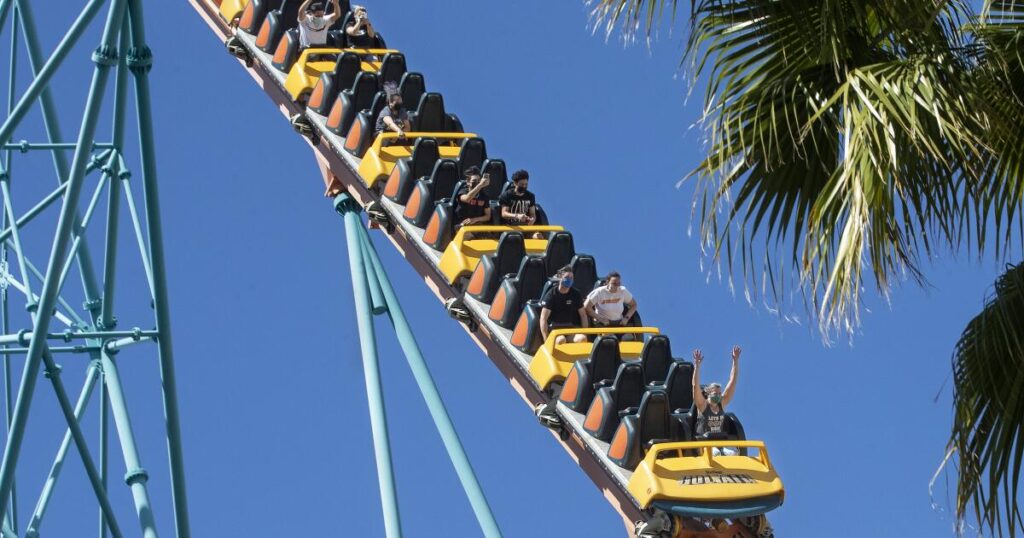Struggling with a plummeting stock price and a decline in revenues, Six Flags Entertainment Corp. named a new CEO Monday, weeks after company officials suggested they would sell more underperforming theme parks.
Six Flags announced John Reilly, a veteran theme park operator, as its new president and CEO. He had served as an interim CEO and chief operating officer at SeaWorld Parks and Entertainment in the past.
Reilly is taking the reins of the struggling Charlotte, N.C.-based company that operates Knott’s Berry Farm in Buena Park and Six Flags Magic Mountain in Valencia.
“He’s got his work cut out for him,” said Martin Lewison, associate professor of business management for Farmingdale State College in New York, who is also a Six Flags shareholder.
Since its merger with Cedar Fair Entertainment Company last year, Six Flags has upset some parkgoers with its cost-cutting efforts, including moving to a regional management model where park presidents at Knott’s Berry Farm and Magic Mountain were laid off. At some parks, live entertainment was reduced or mostly canceled, and some seasonal events did not return this year, such as WinterFest and Tricks and Treats at California’s Great America in Santa Clara.
Lewison said his own experience has been spotty at Six Flags parks, and two issues the company will need to address are how it wants to brand itself, and whether it wants its theme parks to be family-oriented or thrill-oriented.
“The company is just sort of a mishmash of a brand right now,” Lewison said.
While the holidays can be a big driver of traffic to Southern California theme parks like Disneyland, Six Flags’ regional parks have experienced some challenges, Lewison said.
At Six Flags, revenues and earnings were down in the third quarter compared to the same period last year, and there were fewer visitors in October compared to the same month in 2024. Executives earlier this month suggested they’re taking a stronger look at closing and selling off more of its underperforming theme parks.
In an earnings call earlier this month, Brian Witherow, chief financial officer for Six Flags, said certain parks that represent 70% of the company’s earnings are outperforming, while its other parks are struggling.
Witherow said the company had invested more money in maintenance to improve the guest experience at the underperforming parks, “but did not yet achieve the commensurate uplift in profits we were targeting.”
In a pair of examples, Witherow cited a “historically well-maintained” theme park “with a loyal customer base,” where the company was able to “minimize costs without impacting consumer demand or the guest experience,” and earnings grew 14%. Then, he cited an underperforming park, where, despite significant spending to address deferred investment needs, earnings fell significantly.
“Going forward, we intend to be more nimble and strategic in allocating investment dollars, focusing only on our highest potential underperforming parks and the strongest opportunities to deliver near-term returns,” Witherow said. He declined to list which parks were underperforming.
Witherow said it’s a priority for Six Flags to narrow its focus “and shrink our capital needs.”
“We’re going to look at the parks where our returns are the greatest, where the opportunities for growth are the highest, and we’re going to focus on those parks. The other parks we’ll look to monetize and use those proceeds to reduce debt,” Witherow said.
In the third quarter, Six Flags’ underperforming parks saw attendance decline 5%, Witherow said.
The company this month permanently shuttered its Six Flags America theme park and Hurricane Harbor water park in Bowie, Md., and will put up the land for sale. In Northern California, California’s Great America is set to close in the coming years, with its final season either in 2027 or in 2032, depending on whether the company exercises an option to extend its lease by an additional five years.
Could Six Flags be considering selling either of its parks in Southern California? Not at this time, Witherow suggested.
Some of Six Flags’ parks that have high property values are in Southern California, as well as Toronto, but those are parks that “are critical to the long-term growth of the business,” Witherow said. A sale of those properties, “I think from that perspective, would not be something, at least where we sit today, that we would be interested in pursuing.”
Reilly succeeds Richard A. Zimmerman, who announced his plans in August to step down as Six Flags’ president and CEO and will leave the board on Dec. 8.
Reilly will join the company at a time when it is facing pressure from activist investors like New York-based Jana Partners to improve its operations. Last month, NFL football player Travis Kelce joined an investment coalition — which includes Jana Partners — that owns about 9% of Six Flags.
Jana has said it plans to engage with Six Flags’ board and management team to improve the company’s marketing strategy and operations, accelerate technology modernization, assess its leadership and evaluate potential acquisitions.
Zimmerman, in the earnings call, said the company has an “ongoing constructive engagement” with the investment group led by Jana Partners, which includes Kelce. He said following the announcement of the group’s interest in Six Flags, there was a surge of consumer interest, a reaction that “reinforces our confidence that Six Flags is as exciting and relevant as ever.”
“Travis Kelce, influencers of that ilk, have tremendous followings,” Zimmerman said. “Travis Kelce is somebody that’s come to our parks in many of our locations and has an affinity for them. We are going to work very closely with him and his team to make sure that we optimize that opportunity.”
For the third quarter, net revenues were $1.32 billion, down $31 million, or 2% compared with the third quarter of 2024. Adjusted earnings before interest, taxes, depreciation and amortization was $555 million, down by $3 million.
That came despite attendance totaling 21.1 million guests, up 1%. One warning sign was a decline in how much guests were spending inside the theme parks, with more season pass holders visiting but fewer single-day visitors.
There were more warning signs in October. For the five-week period that ended Nov. 2, there were 5.8 million guests, down 11% compared to the same five-week period last year.
Six Flags shares closed Monday at $14.44, up 7%. Its 52-week high was $49.77.
The post Struggling Six Flags names new CEO. What does that mean for Knott’s and Magic Mountain? appeared first on Los Angeles Times.




